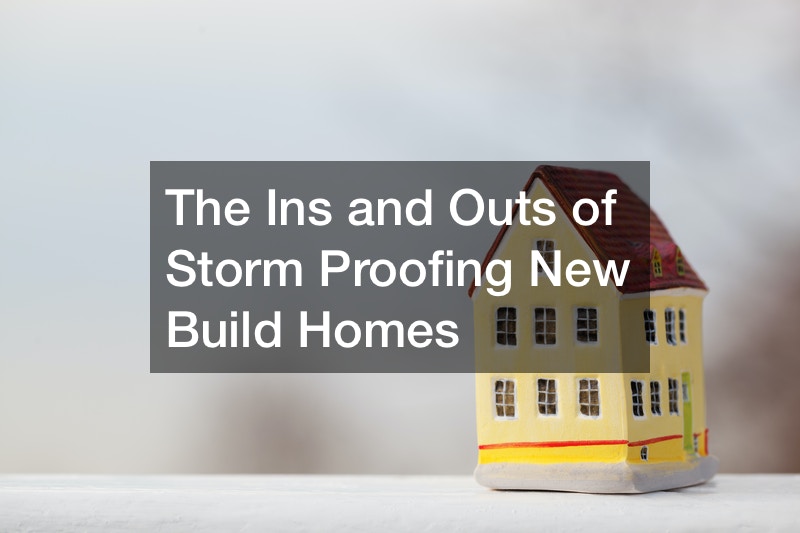
There are a lot of advantages that come with building storm proof homes. For one thing, there is the obvious practical advantage of being safer and being able to avoid the damage that can occur when storms like hurricanes and tornadoes hit. It’s almost expected that houses on coastlines are built to withstand flooding and hurricanes, at least within recent years, while homes in the midwest are often built to brace themselves against extreme winds.
Additionally, storm proof homes often come with a higher value. Although you will need to invest more in building these types of houses than you would non-storm proofed structures, that investment will often pay off with a higher return. It’s estimated that hurricanes fortified against hurricanes sell for 7% more than other homes, according to a study from the University of Alabama.
People interested in storm proof homes often appreciate the fact that they will be not only safer but less likely to pay to repair serious damages after a storm. Even if you’re able to evacuate prior to a serious storm, your property itself will not be out of the woods. You could pay tens of thousands of dollars to repair a home that wasn’t storm proofed — more than you would pay when storm-proofing your home during its initial conception, most of the time.
There is something to building storm proof homes from the ground up, rather than buying a pre-existing house and storm-proofing it. When homes are built from the ground up, they can be more effectively fortified against storms and can additionally be much stronger. That’s because they’ll be built without the flaws that make other homes vulnerable to storms. Although many people look for house sales with a quick turn around, building your house from the ground up will allow you to ensure that it’s storm-resistant. This is especially important if you live in an area prone to hurricanes and tornadoes. With that being said, let’s explore how to build storm proof homes for yourself.

What Affects the Cost of the Project?
There are a number of different factors that affect the cost of a project. When building storm proof homes, homeowners need to balance out what they’re investing into their projects versus what they’ll receive from them. Homeowners may be building homes for themselves, but it’s quite possible that they will sell them later. If they invest more in storm proofing than the market will bear, they will lose out in the long term. The cost of building a storm proof home from the ground up, versus adding storm-proofing to an existing home, should be carefully estimated.
Typically, it’s a safe bet that adding storm-proof modifications to existing structures will cost twice as much as the same modifications would cost when applied to a new house being built. A roofing contractor, for example, will often charge more for modifications made to an existing home than they would when laying a brand new roof on a new home. This is, in part, because it’s often harder to change an existing structure than it is to build a home from the ground up. Additionally, some modifications may require remodeling projects, which can require completely gutting a house. Not only is this more expensive, but it also can take longer. This will inconvenience the homeowners longer and force them to either stay in their existing homes or renting out temporary housing.
Of course, another factor that can affect the overall cost of storm-proofing will be acquiring the necessary supplies for contractors. More expensive supplies can sometimes be of higher quality, but this is not always the case. Just as is the case during normal renovations and home building projects, homeowners need to speak with multiple contractors when building storm proof homes. Contractors can walk through a project and lay out their plans for executing it. They will then place their bids for the project, so homeowners can choose contractors from there. It’s important that homeowners don’t simply choose the least expensive contractors, however. They need to choose contractors that are more experienced, specializing in building homes that are meant to withstand storms. They should compare the costs of the contractors in general, deciding on the contractor that is right for the project based in part on commonalities between pricing.

What Are the Different Types of Storm Proofing Available?
Storm proof houses come in many different forms. Typically, the type of storm proofing a homeowner will invest in will depend on where the home is located. A house that is built near the ocean will need to be built with hurricanes in mind, while a house that is built in the midwest will need to be fortified for tornadoes.
Usually, homeowners are more familiar with the practices that come with building a home that is resistant to hurricanes, as opposed to building a home that is resistant to tornadoes. For example, hurricane shutters are commonly built into hurricane-resistant houses. These protect the windows, which are often the first things to go when a hurricane hits. Windows are not only expensive to replace, but they’re also dangerous when they do break — capable of injuring multiple people and allowing for flooding that will lead to expensive water damage claims. Hurricane shutters protect windows and prevent them from shattering. Ultimately, this can lead to a much safer house in general.
But it should also be remembered that many storm proof houses are built without basements because of hurricanes and flooding. While basements may be common in much of the country, they are difficult to find on America’s coastlines. This is because houses that are built at or below sea level, and therefore within hurricane range, are often more at risk of flooding. The flooding caused during hurricanes can be severe and have long-term consequences. These consequences include wood rot, as well as mold and even disease. Additionally, the short-term hazards caused by severe flooding during a storm can be life-threatening. Electric shocks that occur when people wade through floodwaters while attempting to evacuate can be lethal.
In contrast, many storm proof homes in “tornado country” may be built with basements. This is in part because it can actually be safer for individuals to head underground during a tornado than it would be for the them to actually tornado proof their homes. When building storm proof homes in anticipation of hurricanes, it’s often recommended that wind-resistant doors and windows, as well as hurricane shutters, are installed. While these can be helpful when building a tornado proof home, they may not make as much of a difference in the long term. This is because severe tornadoes create wind speeds so high that the debris picked up in a tornado’s funnel will resemble a missile. Therefore, it can be difficult for people to find ways to make their actual houses truly tornado-proof.
However, a basement remodel can make this underground space a good place to hide and wait out the storm. While homeowners are often told to hide in their bathrooms or closets when a tornado hits, a basement can act as a secure area — especially if a wind-resistant door is installed. Additionally, basements can be quite spacious, with bathrooms available as well as spaces in which food and water can be stored. This means that if homeowners are left waiting for a rescue after a tornado, they will be more comfortable, safe, and healthy. But there are other options available, both for those seeking shelter from tornadoes and those seeking shelter from hurricanes. In some cases, both the space is available and the inclination ready for homeowners to seek out alternative means of waiting out the storm.

What Are the Benefits of Building a Storm Shelter?
There are certain benefits that come with building a storm shelter, while also creating storm proof homes. Residential storm shelters are not always necessary, but they are something to consider if you live in an area particularly prone to severe weather. They should be considered, in particular, by those who live in tornado-prone areas, as it can be more difficult to storm proof a home safely in those locations.
Storm shelters come in many different forms. They can be above ground, in which case they would be noticeable and would resemble a shed. These spaces can in fact be used for storage until they need to be used during a storm, though space should be left for the family in case the shelter needs to be utilized at the last minute.
Another option to consider is the underground shelter. Underground shelters are often more recommended for areas in which tornadoes are common. They may be less effective in hurricane-heavy areas, as they will not necessarily be invulnerable to flooding. Another factor to consider is combining your existing basement space with an underground storm shelter. In this case, you can save money that you would have spent on a basement remodel or a separate shelter, creating a shelter within the home. Not only is this cost-effective, but it also can be easier to reach if an unexpected storm does actually hit.
It’s important for those considering shelters to consult with local real estate agents to see how common they are and how they can affect a property’s value. While a lot of buyers will likely appreciate the addition of a storm shelter, some may not be as excited due to the aesthetic appearance of storm shelters and the fact that they take up space in backyards. Additionally, there are certain individuals that might find a storm shelter built through a basement to be a waste, as they would prefer a finished basement. This is why many individuals prefer to hurricane-proof their houses from the ground up. But those who are tornado-proofing their houses may not have as much of a choice.

What Happens If a House Isn’t Storm-Proofed?
There are a lot of issues that can take place if a home is not efficiently storm-proofed. As previously mentioned, some people balk at the idea of paying for the additional costs that come with storm-proofing their homes. Unfortunately, they may not realize exactly how devastating storm damage can be. Storm proofing a house can keep those within the home much safer than they would otherwise be when riding out a storm. At times, storms come with very little warning and people are forced to sit through them, attempting to wait them out until rescue services arrive. At that point in time, the last thing you will be thinking about is how much your stucco contractor charged for storm proofing services. Instead, you’ll be relieved that you made the investment for more durable materials and extra protection.
As previously mentioned, those who are able to evacuate leave behind houses that can take quite a beating. Tornadoes and hurricanes have both been known to completely level houses to the ground. While storm proof homes are not completely guaranteed to withstand the damages that come with storms, they are typically much stronger than homes that have not been storm proofed. This means that homeowners who have paid for storm proofing may not necessarily have to pay for restoration services (or spend as much money on these services) after the storm passes. The reality is that when a home is severely damaged, homeowners are not simply relieved of their duties. There are still mortgages to pay and damages to repair, and while homeowners’ insurance can help in some circumstances, it is certainly not a foolproof protection against damages.
Clearly, the benefits of buying storm proofing homes from the ground up are manifold. These are less expensive in the long term than existing houses that are storm proofed later and additionally offer great returns on investment. They do require a good deal of work, as everything from windows to plumbing systems need to be as storm proofed as much as possible. But they make for more valuable, safer, and sturdier homes in the long term.


